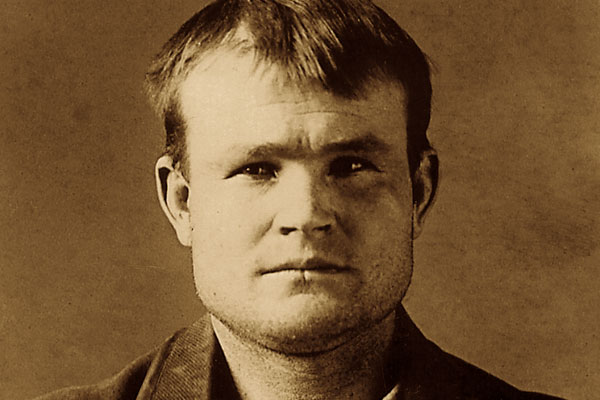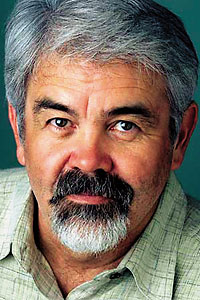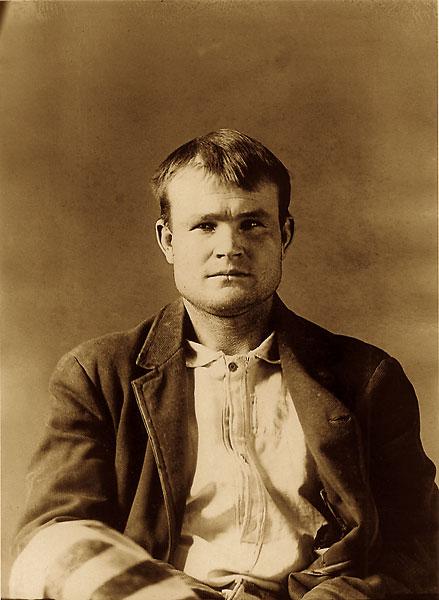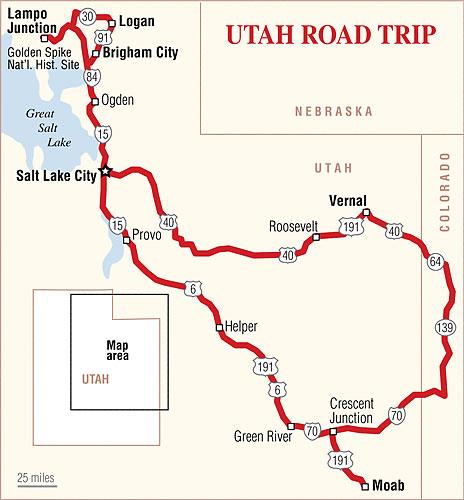 You’re Riding Shotgun With…
You’re Riding Shotgun With…
 Larry Clarkson, a native Utahn, born and raised in the Valley of the Great Salt Lake. He stills lives, with his wife, in the shadow of Mount Olympus.
Larry Clarkson, a native Utahn, born and raised in the Valley of the Great Salt Lake. He stills lives, with his wife, in the shadow of Mount Olympus.
A professor of art and design at Weber State University, Clarkson is also the graphic designer of the Official Utah Travel Guide for the Utah Office of Tourism and has worked for more than 30 years as a graphic designer and visual communications consultant.
He spends his winters skiing the majestic Utah powder in northern Utah and his summers hiking the red rock canyons of southern Utah, and he always has his sketchbook or paint box on hand. His writing and painting have recently been highlighted in the book Painters of Utah’s Canyons and Deserts.
Clarkson takes us on a tour of some of Utah’s historic railroad and mining towns, on a loop that begins at the hub of Salt Lake City.
SALT LAKE CITY, UT
This mountain-rimmed sagebrush valley adjacent to the Great Salt Lake was first traversed by trappers and pathfinders from Jim Bridger to John C. Fremont, but most notably, by the ill-fated Donner-Reed party in 1846. The emigrants’ untimely winter sojourn in the high Sierras made cannibals of these god-fearing pioneers. A 45-minute drive west of Utah’s capital city on I-80 to the Delle exit will hook you up to a dirt road leading to the Hastings Pass Trail that dictated the emigrants’ grisly fate.
A side trip into Grantsville to visit the Donner-Reed Museum is worth your time to see artifacts pioneers discarded from wagons to lighten their load as they ran out of water and their oxen died. It was this same track, but on the east side of the Salt Lake Valley through East Canyon, that Brigham Young and the Mormon pioneers took to enter the Valley one year later.
In Salt Lake City, Mormons still get baptized and married inside the imposing, but beautiful, granite temple fortress at Temple Square. East of the square are the Beehive House and the Lion House—homes of early Mormon Church president Brigham Young and his 50-plus wives and abundant children.
The Salt Lake Valley was actually Mexican territory when the pioneers entered on July 24, 1847. You can contemplate this little-known fact while eating the best “mole” outside of Mexico at the Red Iguana restaurant, just seven blocks west of the square on North Temple street. The line getting in often winds around the building like a wagon train, but the food is worth the wait.
“This is the Place” Heritage Park houses Old Deseret Village, a living history museum that re-creates a typical 1850s Mormon community. For lunch, head down the Old Mormon Trail (now Emigration Canyon Road) about two miles east to Ruth’s Diner. Sip a local brewed beer and chow down on “Grandma Claire’s Baked Mac & Cheese” on the restaurant’s huge outdoor patio.
The Pioneer Memorial Museum, known among the locals as the DUP, offers the world’s largest collection of Mormon pioneer artifacts, from a Conestoga wagon to Victorian hair art made into wreaths.
If you are looking to add a rare book on Mormonism to your Western history collection, visit Ken Sanders Rare Books. Ken could pass for a member of Z Z Top, but while he can’t sing a note, he is a treasure chest of Western lore.
OGDEN, UT
Ogden, named after Hudson’s Bay Company mountain man Peter Skene Ogden, claims to be Utah’s oldest non-native settlement with the building of Fort Buenaventura in 1845 by mountain man Miles Goodyear. Even though it was more a small picket enclosure than a fort, Goodyear pulled a sneaky and sold his claim to the Mormons two years later in 1847; it became known as Brown’s Fort. Today, you can visit a replica of the fort on the original site, along with a visitor center. Stop by on Labor Day and participate in a blackpowder pistol shoot or compete in the tall tales competition at the Fort Buenaventura Rendezvous.
With the completion of the nation’s Transcontinental Railroad in 1869, Ogden became the junction for rail travel in the Intermountain West. Its Ogden Union Station houses three museums: Utah State Railroad Museum (learn about the construction of the Transcontinental Railroad); John M. Browning Firearms Museum (my favorite firearm is the 1911 Colt .45, the U.S. military sidearm for more than 75 years); and the Browning-Kimball Classic Car Museum (houses a 1901 single-cylinder Olds to a 1930 16-cylinder Cadillac, but no Porsches).
Take a stroll up Historic 25th Street, due east of Union Station, where the buildings and storefronts still retain the atmosphere of Ogden during its heyday as “Junction City.” Housed in an 1890 building that was once a house of ill repute is Roosters Brewing Company. Its well-known Polygamy Pale Ale goes great with a Naughty Brewhouse Burger.
PROMONTORY, UT
The joining of the Union and Central Pacific Railroads on May 10, 1869, to become the Transcontinental Railroad took place 50 miles northwest of Ogden at Promontory Summit. At the Golden Spike site, you can view replica steam locomotives “Jupiter” and “119” and participate in re-enactments of the Golden Spike ceremony.
Next up, take a driving tour on the original Transcontinental Railroad grades. A great side trip is the hike to Chinaman’s Arch, named in honor of the Chinese rail workers. Art fans may want to drive a short 16 miles away, on a dirt road, to see Spiral Jetty, the monumental earthwork by Robert Smithson located on the shore of the Great Salt Lake.
UTAH’S CACHE VALLEY
Originally inhabited by the Northwest Band of the Shoshone, Cache Valley was named by mountain men who used it for trapping and caching hides, and as a rendezvous site in 1826.
A Mormon settlement founded in 1859, Logan was named after fur trapper Ephraim Logan. The valley is a prime agricultural area, and Logan is home to Utah State University, Utah’s original 1888 land grant college.
Logan’s downtown features many turn-of-the-20th-century homes and buildings. The Logan Utah Temple, built from 1877-84, rests on a terrace of ancient Lake Bonneville, precursor to the Great Salt Lake. The 1891 Logan Tabernacle is an excellent example of an early Mormon meetinghouse. For more historic homes, take the walking tour in Providence.
After all that walking in Logan, stop by the Bluebird Café and order an Ironpot—a cross between a root beer, coke and cream soda. Be sure to order it with cream.
In nearby Wellsville, the 160-acre American West Heritage Center is the place to be in the summer, when it hosts history re-enactments, folk-life craftspeople and Old West entertainers. You’ll see an Indian village, a mountain man rendezvous, a military encampment, a pioneer settlement, cowboy shoot-outs, a medicine show and loads of great food.
PROVO, UT
Fathers Escalante and Dominguez trekked through the Utah Valley in 1776 to look for an overland trade route from the Spanish mission at Santa Fe to the missions in northern and central California. Fur trappers also visited in the early 1800s, and it is from one, named Etienne Provost, that the Mormon settlement Provo got its name. Founded in 1849, Provo was the first Mormon colony in Utah outside of Salt Lake Valley.
If you are interested in the history of printing, be sure to spend some time at the Crandall Historical Printing Museum. It features fully-working replicas of the presses used by Gutenberg to print the Bible and Franklin to print the Constitution. It also showcases many historical printed samples, including pages of the first edition of the Book of Mormon.
CASTLE GATE & HELPER, UT
Seeking a route from Denver to Salt Lake City in the late 1800s, the Denver and Rio Grande Railroad laid tracks between Provo and Price over Soldier Summit, passing by the railroad and mining settlements of Castle Gate and Helper.
Castle Gate Spire, a single landmark now, was once two striking castle spires before the Utah Department of Transportation blasted one with dynamite so it could widen the road. Castle Gate got its start when the Pleasant Valley Coal Company began mining here in 1886. It was the scene of a daring, but smart, robbery in broad daylight of some $8,000 in payroll gold in 1897. Butch Cassidy and his two accomplices fled to Robbers Roost, cutting telegraph wires along the trail to prevent news of the robbery from spreading to lawmen along their 100-mile escape route.
The town of Helper, northwest of Price, was named after the helper locomotives that still aid trains traveling up the steep grade of Price Canyon to Soldier Summit and over to Provo. The Denver and Rio Grande Railroad established the town in 1891 to take advantage of the nearby coal deposits needed to fuel the steam engines. You can learn more about this story of coal mining and railroad camps with a visit to the Western Mining and Railroad Museum on Main Street.
GREEN RIVER, UT
As you drive to Green River, watch the Book and Roan Cliffs rise dramatically from the lower desert floor. These impassable cliffs have provided hiding places for rustlers, outlaws and hermits over the years, and they were home to the Fremont Indians some 1,000 years ago.
A side trip to view the Indian rock art in Nine Mile Canyon is worth it. The scenic drive is a 100-mile round trip from the Wellington turn-off to the famous “Cottonwood ‘Great Hunt’ Panel” and back on a graded dirt road, so be sure you have plenty of gas, food and water.
A river crossing for the U.S. mail in 1876 and then a fuel and water stop in 1883 when a rail line was built between Salt Lake and Denver, Green River was visited often by bandits traveling between Robbers Roost in south central Utah and Brown’s Park in northeastern Utah. Matt Warner, a relative of mine and a cohort of Butch Cassidy, once owned a saloon and brothel in Green River. I wonder if thievery is in my blood?
Green River is home to the John Wesley Powell River History Museum. Situated on the banks of the Green River, it is a showcase of the trials and tribulations of the expeditions of Powell, a one-armed Northern Army officer veteran of the Civil War, who first floated down the length of the Green River and parts of the raging Colorado. This museum is one of my favorites and is packed with a slew of interesting historical artifacts of river running in the West.
MOAB, UT
On the drive to Moab, you’ll notice the landscape change from grey silt stone cliffs to free-standing sandstone pinnacles and plateaus…welcome to Utah’s red rock desert. To the north is Arches National Park, the largest concentration of natural arches in the world, while to the south is Canyonlands National Park.
Nineteen miles into your drive from Crescent Junction, at highway marker 141, is the dirt road turn-off to Mill Canyon Dinosaur Trailhead. The trail leads to fossilized dinosaur footprints. On the canyon’s south side, you’ll see remnants of an 1800s copper mill along the Moab fault.
Remains of the 1883 Halfway Stage Station between Moab and Thompson are located about a half mile east of the Dinosaur Trail. The first train went through Thompson to Salt Lake in April 1883. The 35-mile stage trip from Moab to the train took eight hours, so travelers stopped at the station for meals.
Your first glimpse of the Colorado River as you drop down off the plateau into Spanish Valley on your way to Moab is an exhilarating sight. During the 1800s the area around what is now called Moab served as the Colorado River crossing along the Old Spanish Trail from Santa Fe.
While in Moab, stop for a drink and some grub at Moab Brewery, which boasts nine locally-brewed beers. My favorite is Golden Sprocket, which goes great with a Reuben sandwich.
BACK TO SALT LAKE
Head back to Crescent Junction and slip into Colorado on the return route for our Utah trip. The next stop will be Vernal.
It lies in Ashley Valley, named in honor of William H. Ashley, a fur trader who entered the basin in 1825 by floating down the Green River in a bull boat. Unlike many Utah towns, Vernal was not settled initially by Mormon pioneers. Yet after the Uintah reservation opened to homesteaders, Mormon settlers did flood into the basin, and Vernal was transformed from a military encampment into a farming community.
Vernal’s saloonkeepers gave Butch Cassidy’s gang the name “Wild Bunch.” Outlaws of all sorts visited Vernal’s watering holes on their way to their hideouts in Brown’s Park. Unfortunately, not too many watering holes are left in Vernal these days.
East of Vernal is Dinosaur National Monument, where the bones of more than a dozen species of Jurassic dinosaurs are still visibly embedded in the rocks. At the Carnegie Quarry Visitor Center, take the 10-mile scenic back roads drive to view the Cub Creek Petroglyphs and the Josie Bassett Morris cabin. Josie was the daughter of Herb Bassett, a rancher who supplied beef and fresh horses to outlaws like “Black Jack” Ketchum, Butch Cassidy, Elzy Lay, Kid Curry, Will Carver and Ben Kilpatrick. Attractive and a bit wild, Josie and her sister, Ann, had relationships with Elza Lay and Butch Cassidy respectively. The two women were reportedly one of a handful of females allowed into Robbers Roost. She died in 1964, at the age of 90, marking her as the last surviving associate of the Wild Bunch.
For a scenic shortcut of the Uintah Basin, take Highway 191 through Indian Canyon, an Indian pathway breaching the Roan Cliffs. Fathers Escalante and Dominguez visited the Uintah Basin in 1776, and locals believe the area is home to lost Spanish gold mines, as well as the treasures of Aztec ruler Montezuma. The drawings of kilts, necklaces and headdresses on the Indian petroglyph panels at McConkie Ranch, in Dry Fork Canyon near Vernal, may have prompted these stories.
The Northern Ute bands who lived here resisted removal but ultimately moved to a reservation by 1869. Land was opened for homesteads in 1905 and, one year later, the town of Dry Gulch City was founded, later renamed in honor of President Teddy Roosevelt.
Ranching, farming and timbering—economic mainstays since the early 1900s—are now supplemented by the vast oil reserves spanning the northeast corner of Utah and into Colorado. Head out of these Uintah Basin fields and return to Salt Lake City.
{jathumbnail off images=”images/stories/Apr-2012/small/larry_clarkson.jpg”}
Photo Gallery
Butch Cassidy











